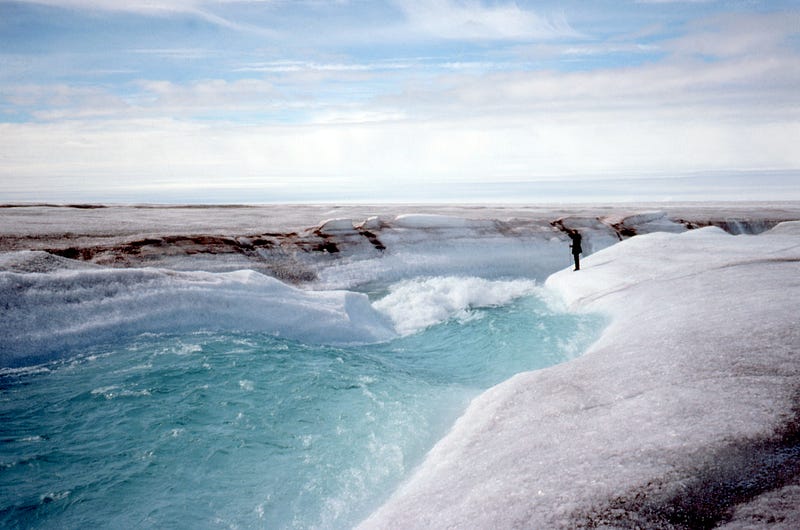The Unthinkable Scenario of a Sunless Earth: Consequences Explored
Written on
The Role of the Sun in Our Lives
It's easy to overlook the significance of the sun on a bright day. However, have you ever pondered its true importance? The sun is not merely a luminous sphere in the sky; it is the vital heart of our solar system. It sustains life, illuminates our days, and even influences our climate.
Each day, the sun engages in nuclear fusion, transforming hydrogen into helium and emitting tremendous energy that radiates throughout the solar system.
When this energy arrives on Earth, it does more than just light our surroundings; it fuels photosynthesis, shapes our weather patterns, and supports modern technology. Essentially, the sun is the unseen force that propels our planet's functioning, making it much more than a star—it's our lifeblood.
The Immediate Impact — An Endless Night

The sun, our nearest star and primary source of energy, plays a crucial role in daily life. If it were to vanish suddenly, the consequences would be dramatic and far-reaching, likely beyond what most can imagine.
Interestingly, the effects of the sun’s disappearance would not be instantaneous. Earth would remain unaware for about eight and a half minutes—the time it takes for sunlight to travel to us. During these fleeting moments, we would still bask in the sun's glow, unaware of the looming darkness.
This delay is a result of the vast distance separating us from the sun. Even at the incredible speed of approximately 186,282 miles per second, light takes time to cover the 93 million miles to reach us. Thus, we would be living in the sun's past, experiencing the final moments of light from a star that had already ceased to exist.
After this brief grace period, the reality of darkness would hit. Unlike the gradual dusk we are accustomed to, this darkness would arrive abruptly, marking the end of our day-night cycle and thrusting us into perpetual night.
Although the sun would be gone, the sky wouldn't instantly become pitch black. Stars and other celestial entities would still emit light for a while, as the last remnants of their glow reach us. However, one by one, these lights would fade from our view, forcing humanity to confront the challenges of a new, dark reality.
Artificial lighting would become our sole source of illumination, effectively replacing the sun. The absence of sunlight would create substantial hurdles, especially since our society heavily relies on solar energy. We would need to quickly seek alternative energy sources to sustain life and civilization, as adapting to a world without the sun would test our resilience and ingenuity.
The first video, "What If We Extinguished the Sun?" delves into the staggering effects of losing our primary source of energy.
Rapid Temperature Drop — The Big Chill

The sun's warmth is critical for maintaining Earth's climate. Its disappearance would halt the heat supply, leading to a swift and severe drop in temperatures. The cooling would begin with the atmosphere and gradually penetrate to the core of the planet.
Initially, in the first week without the sun, average surface temperatures would plummet from around 57°F (14°C) to a frigid 0°F (-18°C). This drastic change would not only be uncomfortable but would also threaten the survival of life as we know it.
As time progresses, Earth would continue to cool, losing its internal heat to space. Within a year, temperatures could plummet as low as -100°F (-73°C). Such extreme cold is typically found in the harshest climates on Earth, making survival increasingly difficult for most life forms.
The long-term implications of this severe cooling would be staggering. The planet's surface would harden, bodies of water would freeze from the top down, and atmospheric gases might condense and fall as snow. This transformation from a habitable world to a frozen wasteland would starkly illustrate our reliance on the sun for warmth and energy.
Oceans Will Transform into Ice

Covering over 70% of Earth’s surface, the oceans act as a significant thermal reservoir, absorbing, storing, and redistributing heat. Without the sun's warmth, these vast bodies of water would begin to freeze, starting from the surface and working downwards.
Initially, the surface would form a layer of ice, acting as an insulating barrier and slowing the freezing of deeper waters. However, over time, the upper layers would solidify entirely, leading to a world where the oceans' surface is covered in thick ice, and life in these waters would struggle to survive.
Interestingly, not all ocean water would freeze. The extreme depths, warmed by geothermal heat from the Earth's core, could remain liquid, allowing some deep-sea life to continue thriving around hydrothermal vents. This scenario would highlight the resilience of life, even in the absence of sunlight.
Photosynthesis Comes to a Halt — The Silent Forests
Photosynthesis, the process through which plants convert sunlight into energy, forms the foundation of most food chains on Earth. Without sunlight, this crucial process would cease, leading to dire consequences for life.
Plants would quickly exhaust their stored energy and begin to die off, resulting in silent forests devoid of the usual vibrancy. This rapid decline would have a domino effect, causing food chains and ecosystems to collapse.
The extinction of plant life would not only impact the flora but also the animals and humans that depend on them for food and oxygen. As oxygen levels drop and food sources dwindle, humanity would face unprecedented challenges, underscoring the sun’s vital role in sustaining life.
The second video, "How Much Water Would Extinguish The Sun?" explores the theoretical implications of our sun's fate and the consequences of its absence.
What Would Life Be Like in Darkness?

While the idea of living without the sun is daunting, it’s important to recognize that life on Earth is incredibly diverse and adaptable. A sunless, frozen world might not be entirely devoid of life. Some organisms, equipped with unique survival strategies, could persist in these harsh conditions.
Deep-sea life forms, adapted to thrive in extreme darkness and pressure, do not rely on sunlight for energy. Instead, they utilize chemosynthesis, deriving energy from chemicals. These organisms around hydrothermal vents might continue to survive even in a sunless world.
Certain microorganisms, known as extremophiles, could also persist. These hardy life forms are adapted to survive in extreme conditions, such as deep in the Earth’s crust or in Antarctica's sub-glacial lakes. They might find ways to endure by tapping into geothermal energy or chemicals.
On the surface, some resilient organisms like cockroaches and certain fungi could also survive for a time, showcasing life's incredible adaptability in the face of adversity.
Earth's Orbital Path Without the Sun
The sun's influence extends beyond light and warmth; it also anchors Earth in its orbital path through gravitational pull. If the sun were to vanish, this gravitational bond would break, resulting in significant consequences for our planet's trajectory.
Currently, Earth orbits the sun in a slightly elliptical path, defined by the balance between the sun’s gravity pulling Earth inward and the planet’s momentum. Without this gravitational force, Earth would move in a straight line, drifting aimlessly through space.
Interestingly, Earth might still retain its moon, as its orbit is governed by our planet's gravity. Even as a rogue planet, Earth might not be entirely alone, with the moon as a silent companion on our journey through the cosmos.